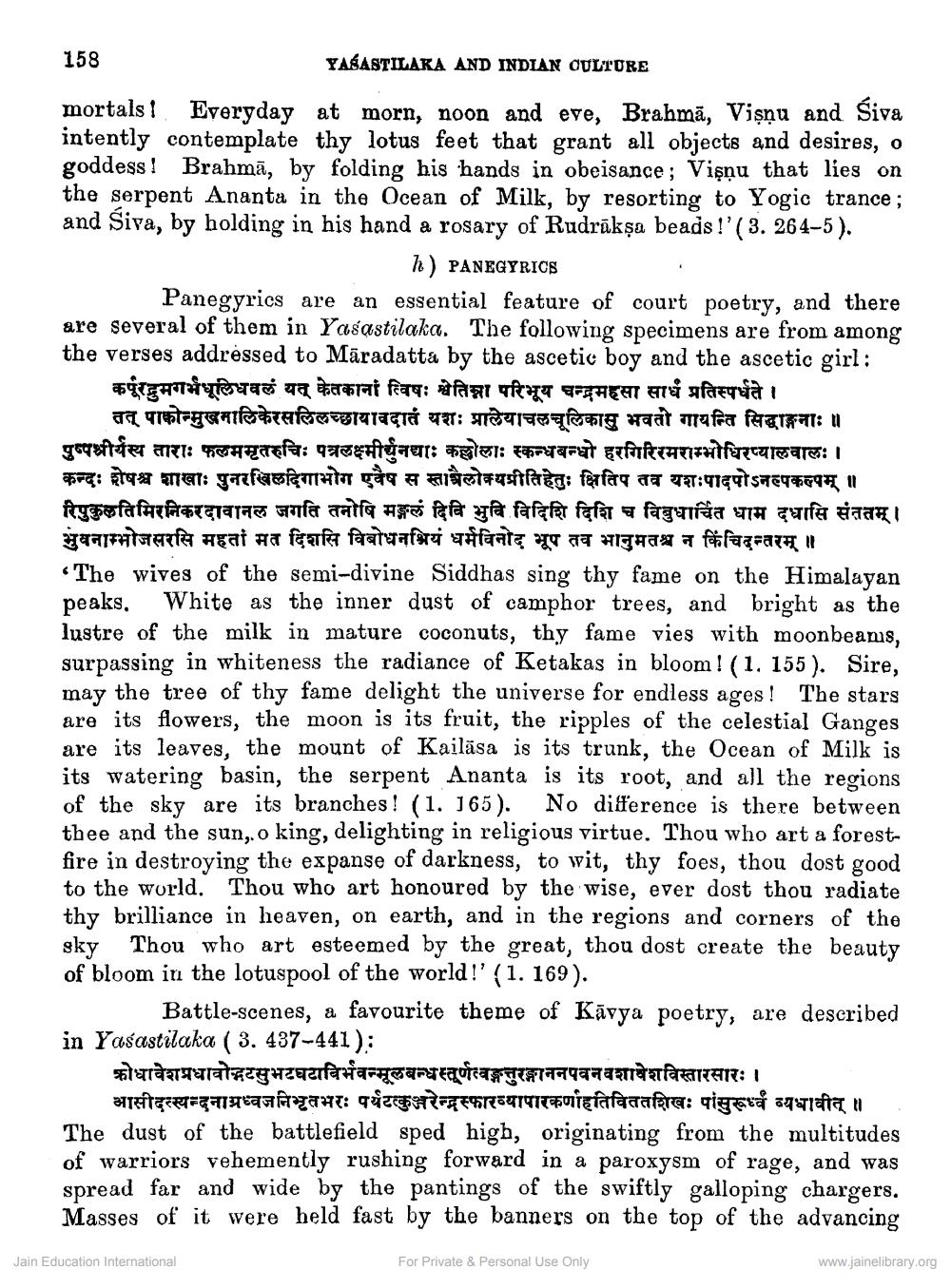________________
158
YAŠASTILAKA AND INDIAN CULTURE
mortals! Everyday at morn, noon and eve, Brahmā, Vişņu and Siva intently contemplate thy lotus feet that grant all objects and desires, o goddess! Brahmā, by folding his hands in obeisance; Vişnu that lies on the serpent Ananta in the Ocean of Milk, by resorting to Yogic trance ; and Siva, by holding in his hand a rosary of Rudrāksa beads !'( 3. 264-5).
h) PANEGYRICS Panegyrics are an essential feature of court poetry, and there are several of them in Yasastilaka. The following specimens are from among the verses addressed to Māradatta by the ascetic boy and the ascetic girl :
कपुरद्रुमगर्भधूलिधवलं यत् केतकानां त्विषः श्वेतिन्ना परिभूय चन्द्रमहसा साधं प्रतिस्पर्धते ।
तत् पाकोन्मुखमालिकेरसलिलच्छायावदातं यशः प्रालेयाचलचूलिकासु भवतो गायन्ति सिद्धाङ्गनाः ॥ पुष्पश्रीर्यस्य ताराः फलममृतरुचिः पत्रलक्ष्मीर्युनद्याः कल्लोलाः स्कन्धबन्धो हरगिरिरमराम्भोधिरप्यालवालः । कन्दः शेषश्च शाखाः पुनरखिलदिगाभोग एवैष स स्तात्रैलोक्यप्रीतिहेतुः क्षितिप तव यशःपादपोऽनल्पकल्पम् ॥ रिपुकुलतिमिरनिकरदावानल जगति तनोषि मङ्गलं दिवि भुवि विदिशि दिशि च विबुधार्चित धाम दधासि संततम् । भुवनाम्भोजसरसि महतां मत दिशसि विबोधनश्रियं धर्मविनोद भूप तव भानुमतश्च न किंचिदन्त “The wives of the semi-divine Siddhas sing thy fame on the Himalayan peaks. White as the inner dust of camphor trees, and bright as the lustre of the milk in mature coconuts, thy fame vies with moonbeams, surpassing in whiteness the radiance of Ketakas in bloom!(1. 155). Sire, may the tree of thy fame delight the universe for endless ages! The stars are its flowers, the moon is its fruit, the ripples of the celestial Ganges are its leaves, the mount of Kailāsa is its trunk, the Ocean of Milk is its watering basin, the serpent Ananta is its root, and all the regions of the sky are its branches! (1. J65). No difference is there between thee and the sun,,o king, delighting in religious virtue. Thou who art a forestfire in destroying the expanse of darkness, to wit, thy foes, thou dost good to the world. Thou who art honoured by the wise, ever dost thou radiate thy brilliance in heaven, on earth, and in the regions and corners of the sky Thou who art esteemed by the great, thou dost create the beauty of bloom in the lotuspool of the world !' (1. 169).
Battle-scenes, a favourite theme of Kāvya poetry, are described in Yasastilaka ( 3. 437–441):
क्रोधावेशप्रधावोद्भटसुभटघटाविर्भवन्मूलबन्धस्तूर्णत्वङ्गत्तुरङ्गाननपवनवशावेशविस्तारसारः।
आसीदत्स्यन्दनाप्रध्वजनिभृतभरः पर्यटकुञ्जरेन्द्रस्फारव्यापारकर्णाहतिविततशिखः पांसुरूवं व्यधावीत् ॥ The dust of the battlefield sped high, originating from the multitudes of warriors vehemently rushing forward in a paroxysm of rage, and was spread far and wide by the pantings of the swiftly galloping chargers. Masses of it were held fast by the banners on the top of the advancing
Jain Education International
For Private & Personal Use Only
www.jainelibrary.org




